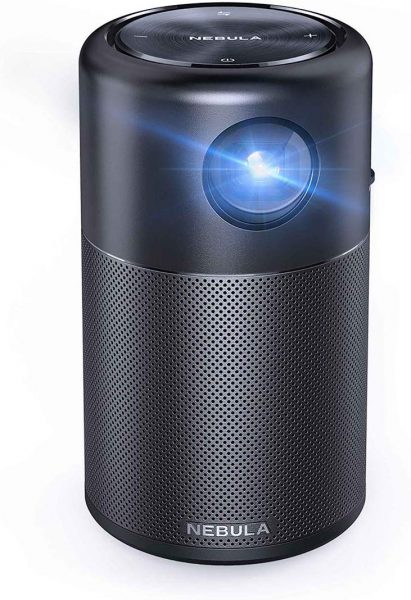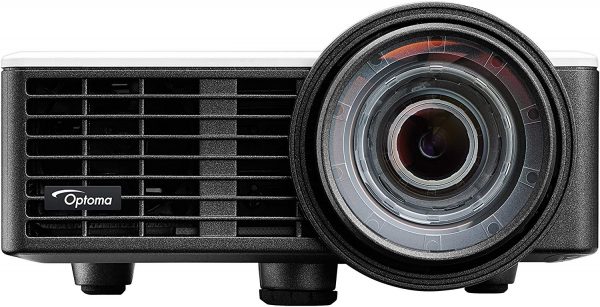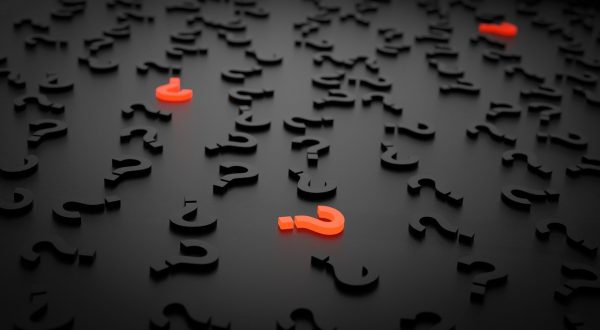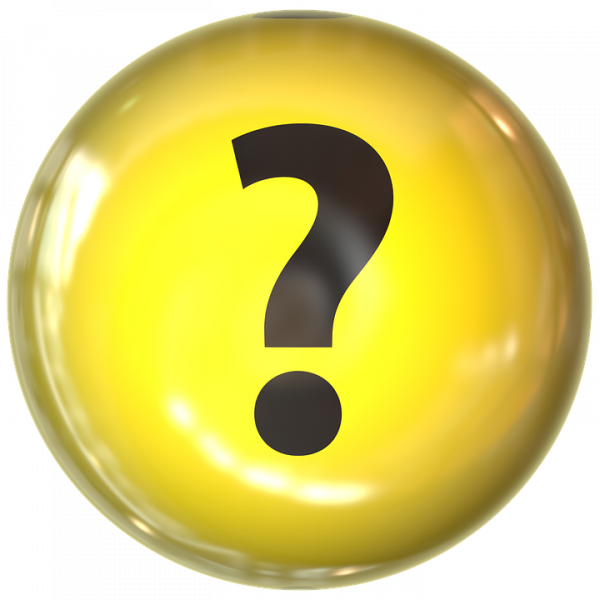A smartphone projector is a must-have for every film geek, gamer or bored child. It’s a fun source of entertainment, and an experience you can share with family and friends. There’s a lot to know about smartphone projectors, and the internet is a big place.
So to help you out, we’ve compiled a list of everything you need to know. What type and model fit your preference, how to set it up, and even how to make your own.
Best Smartphone Projectors To Buy
There are a few places you can buy these projectors. Here are some of the best ones on the market right now.
Anker Nebula Capsule

- OS Compatibility: iOS and Android
The Anker Nebula Capsule is compact and lightweight. Its brightness is up to 100 ANSI lumens, perfect for an intimate movie night with friends. It’s made of aluminum, which makes it more durable. It runs on Android 7.1 and supports Miracast and AirPlay. The device boasts an omnidirectional speaker, which has good audio quality. It also comes with a remote and a MicroUSB charger.
To spice up your next hang out, check out the Anker Nebula Capsule on Amazon.
LG PH550 Cinebeam LED Projector

- OS Compatibility: Android
With its sleek design, the LG PH550 Cinebeam is both stunning and functional. It’s 550 ANSI lumens bright and boasts a 1280 x 720 HD resolution. It is only compatible with Android phones and connects wirelessly. Although it also has HDMI ports. It also comes with a built-in battery that lasts up to 2.5 hours, perfect for your next presentation.
You can buy it on Amazon, just in time for your next report.
AAXA P6 Mini LED Projector

- OS Compatibility: iOS and Android
The AAXA P6 Mini LED projector may be small, but it’s packed with a lot of different features. It’s equipped with multiple ports to connect through HDMI, AV, Mini VGA, and more. It also comes with a remote and a small tripod. It’s 600 ANSI lumens bright and can project up to a 140” screen in low light.
Get the AAXA P6 Mini LED Projector on Amazon for your next family movie night!
Sony MP-CD1 Portable Pico

- OS Compatibility: iOS and Android
If you prefer an easy carry for on-the-go presentations, Sony’s MP-CD1 is for you. With its slim casing, it’s easy to slip into your pocket. It has a brightness of 105 ANSI lumens, showing clean and vibrant pictures. It also supports both Chromecast and Miracast. For Apple devices, you may need to have an adapter handy. And you can even hook it up to a separate speaker for a better audio experience.
If you’re planning on hosting a watch party, be sure to get the Sony MP-CD1.
Miroir HD Mini Tilt

- OS Compatibility: iOS
The Miroir HD Mini Tilt has a cool function that can allow you to tilt it at a 90-degree angle. It can project to an 80” screen at 720p resolution. The battery can last for up to 2 hours, and its LED lamp can last 20,000 hours. It has built-in speakers and a USB charging port so you can charge while presenting. With HD quality and small size, it’s perfect for your important presentations.
To give your presentation a little something, check out the Miroir HD Mini Tilt.
RIF6 CUBE Mini Projector

- OS Compatibility: iOS and Android
The RIF6 Cube is the smallest on this list, standing at 2 inches. Still, it can project videos at up to 120 inches at 50 ANSI lumens. It has many input options. So you can play your slideshows, home videos, and movies right from your USB drive or SD card. It even comes with its tripod to keep the projection stable.
It would be perfect for showing off all your vacation trips to your friends. Don’t forget to grab it here on Amazon.
RAGU Z400 Mini Projector

- OS Compatibility: iOS and Android
The RAGU Z400 mini projector can produce a crisp picture and project at 130” screen. Its fans also produce little noise, which is great for a quiet date night. Its LED has a brightness of 1,800 ANSI lumens showing vivid, HD quality. It can connect to a Bluetooth speaker for clearer audio.
Make your date nights more special with the RAGU Z400 mini projector.
DR.J Professional HI-04

- OS Compatibility: iOS and Android
The DR. J Professional HI-04 supports up to 1920 x 1080 resolution. It’s more of a palmtop projector, so it’s preferable to use this for outdoor viewing. Its lifespan is at 40,000 hours, higher than your average mini projector. It has an HDMI port so you can even hook it up to your laptop and play video games.
Get it here on Amazon before your next outdoor film showing.
Optoma ML750ST

- OS Compatibility: iOS, Android, Windows
The Optoma ML750ST is 700 lumens bright and has an auto keystone sensor. It can project to a 100” screen even at 6 feet away. This product can last for 10 years at an average usage of 5 hours/day. It supports wireless screen mirroring, for connecting to game consoles and other devices. The projector also has its media and document viewer, so you can present PDFs and Office documents.
You can buy the Optoma ML7F0ST here, for both work and play.
Paladone Smartphone Projector

- OS Compatibility: iOS and Android
The Paladone Smartphone Projector is the perfect companion for a quiet night. It comes with a foldable stand for customization, and focus control features. It has a silicone padding to ensure that your smartphone stays in place. It’s also equipped with a port on the side for your earphones and charging. It doesn’t need any batteries or wires to function, which is a plus!
For a hassle-free movie night alone, check out the Paladone Smartphone Projector.
LoongSon Smartphone Pocket Projector

- OS Compatibility: iOS and Android
Cute and travel-sized, the LoongSon Smartphone Pocket Projector is a good buy. It comes in a bright yellow color and weighs under a pound. It doesn’t have a built-in battery, but it comes with a power cord. You can also charge it via a power bank or any other power source. It has many multimedia ports, compatible with USB and SD.
If you’re looking for something that’s both cute and useful, check out the LoongSon Pocket Projector.
Luckies Ltd. Smartphone Projector 2.0

- OS Compatibility: iOS and Android
The Luckies smartphone projector has a DIY element. It’s easy and fun to assemble! Because it’s made out of cardboard, it doesn’t need to be wirelessly connected to your phone. All you need to do is to insert it. It has a silicone padding that keeps your phone in place. Not only will you enjoy your movie night, you can learn a little more about light projection too.
You should get the Luckies Smartphone Projector 2.0 for your next family bonding time.
Where to buy smartphone projectors?
You can buy these smartphone projectors above online. They’re available on Amazon.com right now!
Why Buy a Smartphone Projector?

You may be wondering why you’d want to buy a smartphone projector in the first place. Well, you can use a smartphone projector in several ways.
For an indoor cinema experience
Smartphone projectors can add a fun little twist to your family or date nights. It can turn your living room into an indoor cinema. All you need to do is set up your projector, turn down the lights, and grab some popcorn.
For quick, on-the-go presentations
Presentations are inevitable. Whether you need to give that report for work or if you want to convince your parents to buy you a dog. And it’s not fun to be lugging around a giant projector everywhere. Investing in a mini projector can help remove any other bulky add-ons in your travels.
To understand how light projection works
If you wish, you can even create your smartphone projector from scratch. (More on DIY smartphone projectors later.) It could be a fun way to bond with your kids and learn about light projection.
Finding the Right Smartphone Projector For You

There are different kinds of smartphone projectors to choose from, depending on use. Each type has unique features. Overall, mini projectors are portable, multi-functional and easy to use.
Pico projectors
Pico projectors are roughly the same size as your average smartphone. It’s more portable and easier to carry than palmtop projectors. It would feel like another power bank in your pockets. But due to its smallness, it has limited features and capabilities. If you need a smartphone projector to watch movies with, then this is a good choice.
Palmtop projectors
Palmtop projectors are larger than pico projectors. Thus they have better quality, range, and brightness. This is a more optimal choice for presentations, as it also has more ports available for use. You can connect these to USB drives if you need to.
Phones with built-in projectors

The palmtop and pico are the two common types of mini projectors. But it’s also useful to note that there are existing smartphones with built-in projectors, such as:
Moto Mods (Android) – Moto Mods are slim phones that you can attach certain accessories to. One of the attachments you can add is the Moto Insta-Share projector, which you can use on your next movie night.
Blackview Max 1 (Android) – The projector is at the top of the phone, making it less bulky.
Quantum V (Android) – This phone comes with its adjustable stand, making it easier to follow the screen. You don’t need to keep holding the phone at an angle when watching.
Note: Apple has yet to include the built-in laser projector in the iPhone’s features.
Buying Guide for Smartphone Projectors

Now that you know what you might want, there are a few factors you should consider before buying one.
Things to consider when buying a smartphone projector
- Long battery life – You’re going to want a model with a battery life that can last at least 2 hours. Roughly the same length as a movie or a lecture. But most smartphone projectors can usually last up to 2-5 hours of playback.
- Good quality image – It’s crucial to find a smartphone projector with a good quality image. You want to enjoy the visuals to maximize your viewing experience. Look out for projectors that have high lumens and high image resolutions.
- Functionality – Check whether your smartphone is compatible with each model. Not all projectors can support all operating systems. It may also be useful to check whether you can connect it to other devices. Like a speaker, for example.
Smartphone projector or TV set?
Smartphone projectors have the potential to function as a TV set. Of course, each has its advantages and drawbacks. Here are a few things to know about the two and why you would contemplate buying one over the other
- Budget – Projectors are cheaper than TV sets, and even more so smartphone projectors. TV sets usually cost around $1,000, while a smartphone projector can range from $50 – $300.
- Customization – It’s easier to adjust your screen size on a projector. Whether you’re watching alone or in a group, you can adjust to your preference.
- Portability – As we mentioned earlier, smartphone projectors are portable. Due to its small size, it’s easy to carry smartphone projectors around when traveling. So you’re able to take your favorite shows and games anywhere you want.
- Space conserving – TV sets generally take up more space than projectors. Not only do you have a TV set to worry about, but it also usually comes with a console and other add-ons. With a smartphone projector, all you need is space to store it. You can flash the projection on any wall, and even your ceiling, without taking up much real estate.
But there are still a few things you may have to sacrifice when choosing a smartphone projector over a TV set.
- Lower resolution video quality – A projector can’t offer the same sharpness as a television set. Although a few smartphone projector models can come close.
- Low audio quality – Smartphone projectors only have a limited range with audio. It might not cover a large room as well as a TV can.
- High maintenance – TVs have LEDs that can last you a long time. Projector bulbs might die out over time and may need routine replacement. But there are a lot of available bulbs online.
How a Smartphone Projector Works?

Setting it up
Recommended brightness/lighting
The brightness of a projector depends on the number of lumens or ANSI lumens. A projector with higher lumens has higher brightness. But high lumens doesn’t mean better quality of lighting. The amount of lumens you need varies depending on your environment.
For instance, a more intimate setting may only need 200-300 ANSI lumens of light. While an auditorium may need up to 2,000 or higher. It also depends on the distance between the projector and the screen. You can picture it this way: if you shine a flashlight in the dark, it’s easier to see the light. But if you shine a flashlight in broad daylight, it’s harder to see.
Recommended surfaces
For optimal viewing, we recommend that the projector face a blank white wall or ceiling. It’s also better to watch it on smooth surfaces.
Recommended phone size compatibility
Depending on the product, phone size compatibility will differ. But a typical smartphone projector generally fits phones that are 3 x 6 in.
Connecting your smartphone to your projector
Screen mirroring is a way to connect your device to a projector wirelessly. Once connected to your projector, it will flash whatever is on your phone screen. Don’t confuse this with screencasting, which is streaming from phone to TV.
You should be able to toggle screen mirroring on your phone settings. But some smartphone projectors need you to download a compatible app. Here are a few examples of projectors with app remotes.
- Multipresenter – for NEC Display (iOS and Android)
- Epson iProjection – for Epson (iOS and Android)
- Projection Simulator – for Sony (iOS and Android)
Another way to connect your smartphone to your projector is through HDMI or VGA cable. For some models, you may need an adapter.
Some smartphone projectors only need you to place your phone inside. These come with protective padding to keep the phone in place. This is common with homemade projectors as well.
How to Make Your Own Smartphone Projector?
Of course, if you want to try out a smartphone projector without having to buy one, you can always make some on your own.
You can find the materials at home. All you need is a cardboard box or even a shoebox. For the lens, you may use a magnifying glass or just a regular lens.
The step-by-step guide below can show you the most efficient way to do so.
